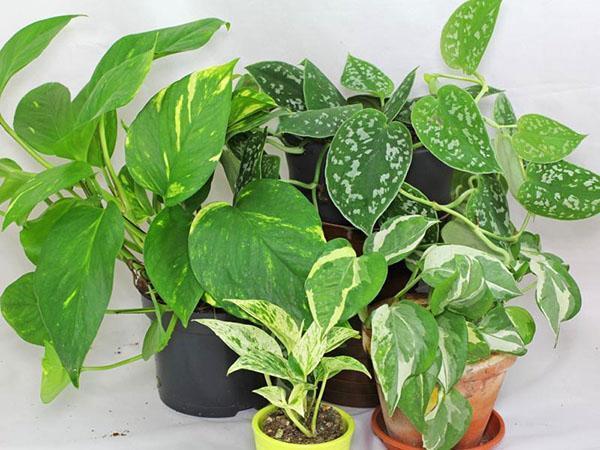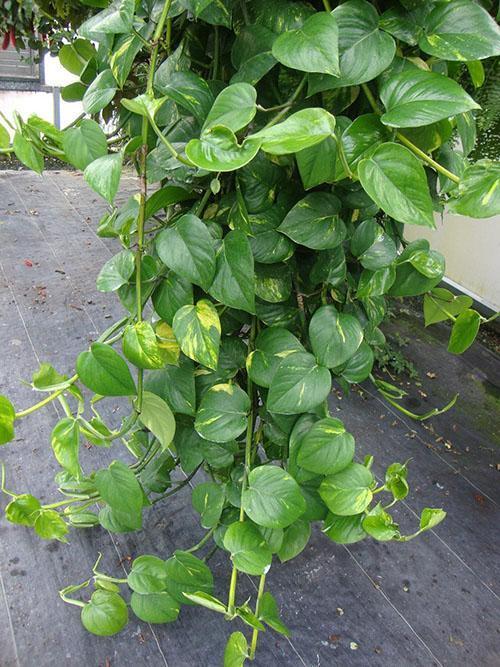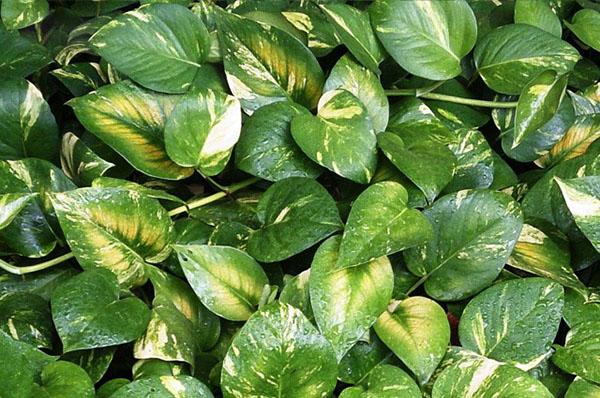Types and varieties of scindapsus for growing at home
 Scindapsus is one of the most popular indoor vines among amateur flower growers. To understand how diverse and decorative this culture is, you should pay attention to the types and varieties of scindapsua for growing at home.
Scindapsus is one of the most popular indoor vines among amateur flower growers. To understand how diverse and decorative this culture is, you should pay attention to the types and varieties of scindapsua for growing at home.
Plants belonging to the huge family of Aroids naturally inhabit the tropical forests of Malaysia, Java, French Polynesia and many other parts of Southeast Asia. Starting from moist, nutritious soil at the foot of the trees, scindapsus quickly climb the trunks, easily reaching a height of 8–10 meters. Home specimens are more modest in size, but thanks to breeders who have created varieties with bright multicolored foliage, they are much more original in appearance.
Due to the huge number of species, the remoteness of their natural habitat and the ability to dramatically change with growth, most genera of Aroids have not been sufficiently studied. Therefore, many varieties of scindapsus botanists and growers of indoor crops are classified as epipremnums, potos or rafidophores.
Scindapsus golden (Scindapsus aureus)

The flower gained popularity among gardeners dealing with indoor plants due to its unpretentiousness, rapid growth and unique foliage.
 A herbaceous vine with pointed-heart-shaped leaves grows up to 2 - 4 meters at home, needs a solid support or is grown as an ampelous plant. In nature, this species scindapsus climbs steep tree trunks, mossy rocks and other surfaces perfectly with the help of powerful, tenacious aerial roots. A bright decoration of the flower is leathery smooth leaves 10 to 20 cm long.
A herbaceous vine with pointed-heart-shaped leaves grows up to 2 - 4 meters at home, needs a solid support or is grown as an ampelous plant. In nature, this species scindapsus climbs steep tree trunks, mossy rocks and other surfaces perfectly with the help of powerful, tenacious aerial roots. A bright decoration of the flower is leathery smooth leaves 10 to 20 cm long.
The older the plant and the better the care, the larger the leaf plates. At the same time, in the shade, the leaves are darker and more evenly colored than those that are under the scattered rays of the sun.
Today, flower growers have many dissimilar ones at their disposal, intended for growing at home varieties of this type of scindapsus.
 Scindapsus pinnate Neon does not belong to variegated varieties, it cannot be confused with any other variety. The graceful, pointed leaves of the plant are painted in a bright lemon-greenish hue that does not change as it grows.
Scindapsus pinnate Neon does not belong to variegated varieties, it cannot be confused with any other variety. The graceful, pointed leaves of the plant are painted in a bright lemon-greenish hue that does not change as it grows.
 The true Golden Queen among scindapsus is the Golden Queen with green leaves generously strewn with white-yellow or lemon spots and touches. The indoor cultivation variety of scindapsus does not have a single repeating pattern on the leaf plates. All are truly bright and unique!
The true Golden Queen among scindapsus is the Golden Queen with green leaves generously strewn with white-yellow or lemon spots and touches. The indoor cultivation variety of scindapsus does not have a single repeating pattern on the leaf plates. All are truly bright and unique!
 Scindapsus pinnate variety N-joy is covered with large spots of white and silvery-green shades. A great decoration for the home, in which there is a comfortable place for a flower in partial shade. Here the plant will fully reveal its exotic beauty.
Scindapsus pinnate variety N-joy is covered with large spots of white and silvery-green shades. A great decoration for the home, in which there is a comfortable place for a flower in partial shade. Here the plant will fully reveal its exotic beauty.
 A feature of the Marble Queen variety is the abundance of chaotically scattered strokes, because of which it is difficult to say which leaf plates were originally white or green.
A feature of the Marble Queen variety is the abundance of chaotically scattered strokes, because of which it is difficult to say which leaf plates were originally white or green.
Scindapsus painted (Scindapsus pictus)
 Scindapsus painted or spotted - a native of distant Malaysia.In humid forests, lianas covered with variegated asymmetrical leaves climb trees, clinging to trunks with the help of aerial roots and receiving additional moisture from the air.
Scindapsus painted or spotted - a native of distant Malaysia.In humid forests, lianas covered with variegated asymmetrical leaves climb trees, clinging to trunks with the help of aerial roots and receiving additional moisture from the air.
A characteristic feature of this species is the unusual shape of pointed-cordate leaf plates, one side of which is smaller than the other. A bright white border runs along the edge of the sheet, and silvery-white spots are scattered throughout the area.
 Among the popular varieties for growing at home is the painted scindapsus Argyraeus, in addition to which, flower growers love and appreciate the silvery variety of the plant.
Among the popular varieties for growing at home is the painted scindapsus Argyraeus, in addition to which, flower growers love and appreciate the silvery variety of the plant.
Siamese Scindapsus (Scindapsus siamensis)
 Among the types of scindapus suitable for indoor cultivation, there is another plant with variegated asymmetric leaves. It is a Siamese scindapsus native to Southeast Asia. The radical difference between the culture is very large leaf plates that seem lighter due to the abundance of silvery or light green merging spots.
Among the types of scindapus suitable for indoor cultivation, there is another plant with variegated asymmetric leaves. It is a Siamese scindapsus native to Southeast Asia. The radical difference between the culture is very large leaf plates that seem lighter due to the abundance of silvery or light green merging spots.
Scindapsus perakensis (Scindapsus perakensis)
 A rare type of scindapsus, in which pointed-arrow-shaped leaves are not variegated, but smooth green. At the base of each leaf plate there are winged appendages, bordering the elongated petiole on both sides. The plant is native to Thailand and the Pacific Islands in height can reach five meters. In a pot culture, it is somewhat smaller, but just as unpretentious as other more common varieties and types of scindapsus for growing at home.
A rare type of scindapsus, in which pointed-arrow-shaped leaves are not variegated, but smooth green. At the base of each leaf plate there are winged appendages, bordering the elongated petiole on both sides. The plant is native to Thailand and the Pacific Islands in height can reach five meters. In a pot culture, it is somewhat smaller, but just as unpretentious as other more common varieties and types of scindapsus for growing at home.
Scindapsus Troiba (Scindapsus treubii)
 Scindapus Troiba, which is widespread in nature on the territory of Java, Borneo and Malaysia, is also a collection rarity. A characteristic feature of the species is rather narrow pointed leaves with a dense leaf plate and unhurried growth, compared to other varieties.
Scindapus Troiba, which is widespread in nature on the territory of Java, Borneo and Malaysia, is also a collection rarity. A characteristic feature of the species is rather narrow pointed leaves with a dense leaf plate and unhurried growth, compared to other varieties.
 Today, florists have at their disposal an original variety with greenish-gray waxy leaves, edged with a green stripe and the same central veins. Due to its non-capricious disposition and slow growth, this type of scindapsus is excellent for vivarium decoration.
Today, florists have at their disposal an original variety with greenish-gray waxy leaves, edged with a green stripe and the same central veins. Due to its non-capricious disposition and slow growth, this type of scindapsus is excellent for vivarium decoration.